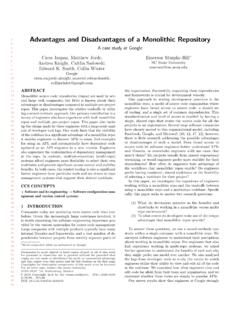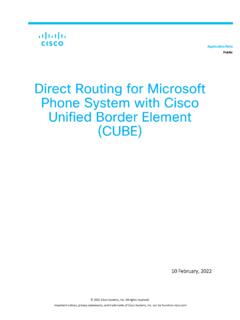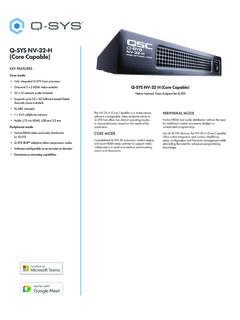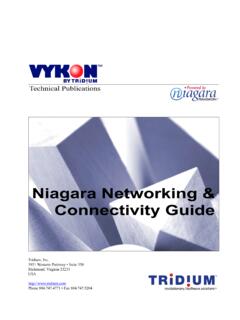Transcription of Web services: SOAP, WSDL, UDDI - NCSU
1 Lecture 24 Object-Oriented Languages and Systems 1 Web services: SOAP, WSDL, uddi A Web service is a software system that supports interoperable machine-to-machine interaction. Interaction means that more than one application is involved. Interoperable means that applications can operate with one another without sharing the same platform, operating system, programming language, etc. Web services are largely delivered by a troika of protocols: SOAP (Simple Object Access Protocol), WSDL (Web Services Description Language), and uddi (Universal Description, Discovery, and Interoperability). These three build on XML (the metalanguage for the representation) and HTTP, the transport protocol In overview, SOAP defines a uniform way of passing XML-encoded data.
2 WSDL allows service providers to specify what a web service can do, where it resides, and how to invoke it. uddi provides a mechanism for clients to dynamically find other Web services. In SOAP messages, the name of the service request and the input parameters take the form of XML elements. WSDL describes the data types and structures for Web services, and tells how to map them into the messages that are exchanged. uddi provides a repository for Web-services descriptions. An uddi registry can be searched on various criteria to find all kinds of services offered by businesses. 2005 Edward F. Gehringer CSC/ECE 517 Lecture Notes, Fall 2005 2 SOAP Let s first take a look at SOAP. Take a very simple search request: +trackball This invokes Google with the search terms laptop and trackball.
3 Google returns lists of pages that entirely depend on matching the given text strings. XML provides a lot of advantages over simple text-based search. It allows the preceding request to be refined and contained in an XML document: <SOAP-ENV:Body> <s:SearchRequest xmlns:s= > <p1>laptop</p1> <p2>trackball</p2> <p3>maxWeight </p3> <p4>OS MacOS</p4> </s:SearchRequest> </SOAP-ENV:Body> What are some of the advantages of sending the request in XML? This example also illustrates the use of an XML namespace (xmlns:). A SOAP message1 contains four parts: The envelope the top-level XML element The header metadata about the SOAP message 1 This example is taken from Eric Newcomer s Understanding Web Services: XML, WSDL, SOAP, and uddi Lecture 24 Object-Oriented Languages and Systems 3 The body the data that is being sent for the receiver to process.
4 The attachment data, usually binary, that shouldn t be represented in the body but is needed for processing. Here is an example SOAP message. <env:Envelope xmlns:env=" "> <env:Header> Headers </env:Header> <env:Body> Body </env:Body> </env:Envelope> Here is an example of a SOAP header: <env:Header> <n:broadcastService xmlns:n="http:// "> <n:list>PDA, Cell, Email, VoiceMail, IM</n:list> </n:broadcastService> </env:Header> The header block is optional; it defines attributes of the message. The body block contains the message itself: <env:Body> <m:Function xmlns:m="http:// "> <m:message> Eric, you are late for the concall again! </m:message> </env:Body> 2005 Edward F.
5 Gehringer CSC/ECE 517 Lecture Notes, Fall 2005 4 (Note: The Web-service integration package XMLBus is being replaced by IONA s Artix, ) In this example, the meeting reminder message will be broadcast to the device list by the send service located at the address defined by the URL: Separate namespaces (broadcastService and function) are used to qualify the element and attributes for each part of the message. This simple one-way message can be bound to HTTP using POST: Request header: POST /broadcastService Host: Content-Type: text/xml; charset= utf-8 Content-Length: nnnn <?xml version= ?> .. SOAP request document There s no response in this case, but if there were one, it would look like this: Response header: 200 OK Content-Type: text/xml; charset= utf-8 Content-Length: nnnn <?
6 Xml version= ?> .. SOAP request document The HTTP header indicates that the document is being sent to the broadcastService at the indicated URL. When the program implementing the broadcastService receives the message, it will decode the body block and execute the send Lecture 24 Object-Oriented Languages and Systems 5 Although SOAP is usually used over HTTP, it can be used over other protocols as well, , SOAP messages are exchanged in various Message Exchange Patterns (MEPs). Request-Response: A request SOAP message is sent, and a response SOAP message is returned. Request: No response is needed. Response: Response is to a non-SOAP request of some sort. SOAP Attachment An attachment is data in the SOAP message that isn t part of the XML body.
7 An example would be a JPEG photo of an accident that must be submitted as part of an insurance claim. A SOAP attachment can take various forms. Encoded as part of an HTTP POST (SOAP with Attachments (MIME), Direct Internet Message Exchange DIME)) A URI that points to an external resource that be accessed with HTTP GET. Here is an example of a SOAP attachment. POST /insuranceClaims HTTP headers --MIME_boundary Content-Type: text/xml; charset=UTF-8 Content-Transfer-Encoding: 8bit Content-ID: <?xml version=' ' ?> SOAP Message 2 The following discussion is adapted from a 2003 guest lecture by Michael Thomas, 2005 Edward F. Gehringer CSC/ECE 517 Lecture Notes, Fall 2005 6 --MIME_boundary Content-Type: image/tiff Content-Transfer-Encoding: base64 Content-ID.
8 Base64 encoded TIFF --MIME_boundary How SOAP Relates To Other Standards WSDL is the interface definition for SOAP. uddi is the registry for SOAP. There are other standards built on top of SOAP: Security Transactions BPEL4WS (Business Process Execution Language for Web Services) WS- routing WSDL The Web Services Definition Language was created to describe the formats and protocols of a Web service in a uniform way. WSDL elements describe the data and the operations to be performed on it. Both are described in terms of XML schemas. WSDL is usually used with SOAP. In order to communicate, both sender and receiver must have access to the same XML schema. If both are using the same schema, any implementation of the Web service can be used, , CORBA, COM, EJB.
9 The following WSDL components exist: Lecture 24 Object-Oriented Languages and Systems 7 <definitions> <types> definition of types </types> <message> definition of a message </message> <portType> definition of a port </portType> <binding> </binding> </definitions> <types> refers to data types used in the messages. These may be defined in XML schemas or in some other way. <portType> is analogous to a function library. Defines the Web service, operations that can be performed and the messages involved. Can be used in multiple transports through various bindings. Examples include .. One-way operation: No response will be sent. Request-response operation: Accept request and send a response.
10 Solicit response: Requestor will wait for a response. Notification: Operation can send a message but won t wait for a response. <binding> is the message format and protocols for the Web services. Request-response operation <message name="getTermRequest"> <part name="term" type="xs:string"/> </message> <message name="getTermResponse"> <part name="value" type="xs:string"/> 2005 Edward F. Gehringer CSC/ECE 517 Lecture Notes, Fall 2005 8 </message> <portType name="glossaryTerms"> <operation name="getTerm"> <input message="getTermRequest"/> <output message="getTermResponse"/> </operation> </portType> One-way operation <message name="newTermValues"> <part name="term" type="xs:string"/> <part name="value" type="xs:string"/> </message> <portType name="glossaryTerms"> <operation name="setTerm"> <input name="newTerm" message="newTermValues"/> </operation> </portType > WSDL binding This signifies that the binding is to the SOAP protocol format envelope, header, and body.




